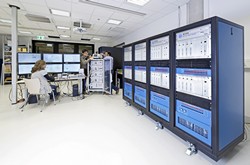Intelligent utilisation of grid assets
As electricity production becomes even more decentralised, the need to handle fluctuations intelligently grows continuously. Real-time data about load patterns is essential for utilities to see how their grid is performing and make necessary adjustments if, for example, any component is overloaded or the quality of supply does not meet customers’ requirements. Without detailed data, it is nearly impossible to locate problems and determine their cause. The EU-funded project IDE4L (Ideal grid for all) was launched with the aim of designing and demonstrating innovative concepts for distribution management in networks integrating renewable energy resources (RESs). A side goal was to improve the reliability of traditional distribution networks. Smart grid architecture ‘Distribution network automation includes the whole chain, starting from control centre information systems, substation automation and ending with home energy management systems, explains Professor Sami Repo from the Tampere University of Technology in Finland, the project’s scientific coordinator. ‘The automation concept developed in IDE4L revolves around three points: firstly, hierarchical and decentralised control over distribution network automation based on international standards, secondly virtualisation and aggregation of distributed energy resources (DERs), and lastly iii) large-scale utilisation of DERs in active network management,’ he adds. Commercial aggregators buy and sell energy. They work together with distribution system operators (DSOs) to meet technical constraints in their operation. On the other hand, aggregators can also provide flexibility services to DSOs as well as ancillary services to transmission system operators (TSOs). Decentralised fault location isolation and supply restoration (FLISR) ‘FLISR is part of the distribution automation infrastructure designed and developed within IDE4L. The basic elements are decentralised intelligent electronic devices (IEDs) that provide protection, logic selectivity and backup chronometric selectivity functionalities. IEDs control circuit breakers and switches’, notes Prof. Repo. IEDs communicate horizontally with peers using the IEC 61850 standard. Generic object oriented substation event (GOOSE) interlocking messages are used for the implementation of two-step logic and chronometric selectivity schemas, and for the integration of the control functions for DERs. The FLISR solution can reduce the number of customers that experience power outages in the event of a fault and isolation of the affected area in mere seconds. The loss of load can thus be shorter than traditional schemes with logic selectivity where decisions are taken at the control centre. In a real operating environment Considerable work went into the design, development and testing of individual components of the architecture before testing subsets of the overall system in a real operating environment. Testing individual components was not enough. Partner laboratories tested several components together before bringing them to the field. Tests were conducted in both simulated and prototype environments integrating architectures, algorithms and tools. Once the overall IDE4L architecture had been validated, technologies provided by partner development laboratories were applied in real demonstration scenarios. ‘Three field demonstrations were carried out by three partner DSOs, Østkraft in Denmark, Unareti in Italy and Union Fenosa Distribution in Spain’, notes Prof. Repo. ‘Real-time monitoring and control use cases provided valuable information on what is happening and how adverse interactions might be diminished in in the low voltage grid.’ ‘IDE4L project has also proposed to utilise monitoring data to enhance network design and distribution planning by defining more accurate customer clusters and profiles. This will be of great importance in the future as customer behaviour changes dramatically with increased use of RESs and DERs,’ he concludes.







